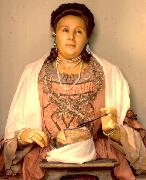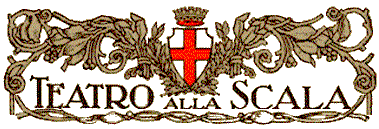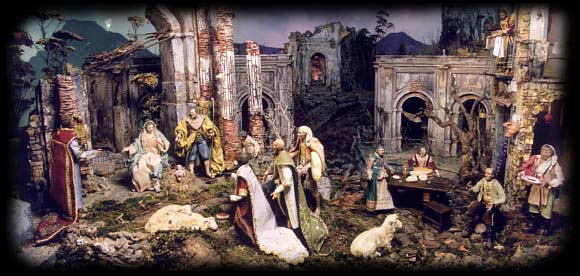
DECEMBER MEETING
FOOD, WINE, AND MUSIC,
METAPHORS OF ITALIAN CULTURE
A CELEBRATION OF CHRISTMAS
|
Our December program will celebrate our cultural heritage, as well
as the season, through the special symbols for which Italy is famous worldwide
- food, wine, and music, symbols of the Italians' love of life in all its
richness and pleasures. In this regard, we have chosen a very special
menu and appropriate wines accompanied by a bit of seasonal music - all
of which we believe will make for a most enjoyable and memorable evening.
The cost will be $40 per person. A copy of the menu is enclosed.
Because of the advance preparation required for the dinner, we must
have your reservations by December 6 and we will be unable to accommodate
late reservations or "walk-ins" as we are strictly limiting attendance
to 72 people.
Also, at this meeting there will not be a gift exchange. Instead
of bringing a gift, we suggest that a donation be given to a charitable
cause.
|
Next Meeting December 15
Cocktails 6:30 PM - Dinner 7:00 PM
Da Baldo's Restaurant

RECAP OF NOVEMBER MEETING
The Kinesthetic Visions
of Anna Morandi Manzolini
At our November meeting, Dr. Rebecca Messbarger, Assistant
Professor of Italian at Washington University, shared her investigation
regarding “Anna Morandi Manzolini’s Anatomical Wax Figures”. The
following is an excerpt of Dr. Messbarger’s abstract.
“During the Italian Enlightenment, science took claim of the human
body. The “Era of Uncovering” pulled skin away from muscle, sectioned
surface from deep musculature, cut flesh from bone in order to know and
to convey the real of life-matter. No longer viewed strictly as a
final act of recompense by a barber surgeon on the body of the condemned,
dissection won legitimacy as a primary field of inquiry within the anatomical
sciences, a field explicitly sanctioned and advanced by the supreme moral
arbiter of the Enlightenment period, Pope Benedict XIV. Dissection
and the systematic representation of the dismembered human form in written
and visual texts signified a new narrative of the body in which coalesced
disparate questions and conceptual fields: life and death, matter
and form, art and science, sense and cognition, word and image, body and
mind. Underlying the scientific renderings in word and image of the
body was the belief that explicit knowledge of the composition and mechanics
of human matter would lead to an understanding not only of the life force
but also of the very structure and nature of reality itself.
The anatomical wax sculptures of eighteenth century Bolognese artist
and anatomist Anna Morandi Manzolini (1716-1774) epitomize the poetics
and design of this new body narrative. Morandi defied her meager
origins and the profound limits of her sex to become one of the most acclaimed
anatomists and anatomical designers of the Italian Enlightenment.
Her meticulous wax sculptures of the bodies she helped to dissect manifest
the intimate partnership between the taxonomic eye and the probing hand
that marks the new Enlightenment world order. Resistant to both the
neoclassical ideal as well as the canon of topographical anatomy, her sculptures
and voluminous explanatory notes offer a reformative body narrative devoid
of moral allegory that envisions each organ in terms of its vital function
within the context of a dynamic interdependent biological whole.
She focuses on the hand for what it will disclose about the sense of touch,
the eye for what it reveals about sight, and the mouth for what it will
tell us about the sense of taste. She simultaneously visualizes and
theorizes links between the body’s various structures in order to locate
the way and the site of convergence between human matter and the life force.
Not surprisingly, Morandi specifically fixes in her work on the hand and
eye, those organs essential for dissection, sculpture and a direct knowledge
of the material foundations of human existence.
However, it is Morandi’s visual autobiography, her life-size wax self-portrait
that not only renders transparent the artist’s vision of the power of the
hand and its ideal alliance with the eye for recounting the truth of the
body, but that also testifies to the real of scientific inquiry.
The ornate apparel and jewelry of Morandi’s imposing facsimile prove only
a momentary distraction from the primary focus of the portrait, her dissection
of a human brain. Staring thoughtfully forward, the woman scientist
prepares to penetrate with the scalpel in her right hand the seat of human
intellection. Morandi represents that climactic moment at which her
discerning hands take possession of the body’s master organ and dispatch
substantial and immediate truths to the abstracting eye. Unlike the
myriad representations she created of living eyes, hands, mouths, and even
bones, the brain set on the wooden dissection table before Morandi’s self-replica
is inanimate. An indistinct mass of neural tissue, the spent organ,
to which tufts of human hair still cling, highlights the dirty business
of science, which involves in this case the penetration of the dead body.”
During Dr. Messbarger’s presentation, we had the opportunity to see
slides of Dr. Morandi’s work. Since the sense organs were the focus of
her work, she had many wax figures of eyes and hands. .Dr. Morandi and
her husband, Dr. Manzolini, gave dissection lessons in their home, instructed
surgeons and medical students in human anatomy and created these wax figures.
After her husband died when she was 39, Dr. Morandi’s continued the work
on her own. In 1761, she became the Chairperson of the Anatomical
Modeling Department. She also sculpted a life-size wax portrait of
her husband dissecting a heart. In addition to her life-like wax
sculptures, Dr. Morandi left a 250-page notebook, which indexes figures
and mechanics of human anatomy. Before her death in 1774, she became
internationally renowned. Catherine the Great, one of her most famous
admirers, requested a copy of her self-portrait.
|
|

L'angolo del presidente
by Gene Mariani
| TOGNONI ELECTED DIRECTOR |
In the election held at the November 17 meeting, James Tognoni
was elected to the Board of Directors of the Club for a three-year term
of office commencing January 2000. Tognoni will replace Peter
Puleo, whose term of office expires at that time. Many thanks
to Peter for his service to the Club as a member of the Board. Peter
continues to serve as the Club's representative on the Board of the Federation
of Italian-American Organizations. Many thanks also to member Patty
Viviano, who ran against Jim Tognoni, for her willingness to serve
the Club. She continues as a member of the Club's Program Committee. |
|
BENVENUTE!
At the November meeting two new members were accepted into the Club.
We are pleased to welcome Mary Ann Gordona Nessel and Evelyn
Borghesi Pellegrin. Mary Ann's family comes from Lombardy (Sondrio)
on her father's side and from Lazio and Lombardy on her mother’s side.
Evelyn's father was born in Tuscany (Bagni di Lucca) and her mother in
Sicily (Palermo). |
|
| |


ANNOUNCEMENTS
| TICKETS FOR LA SCALA |
The 1999 – 2000 opera season at La Scala's runs from December 7, 1999
(Ludwig Van Beethoven’s Fidelio) to November 4, 2000 (Luigi Nono’s
Prometeo).
The ticket office is open seven days a week from 12 noon to 6 P.M. except
on national holidays. Tickets for the same evening's performance
are sold at the box office until fifteen minutes after the performance
begins. The ticket office begins selling any tickets left over from
Internet and telephone sales one month prior to performances. Tickets
may also be purchased through the ReteBIT (Bank, Internet, Telephone) system
two months before any performance. They range in price from 120,000
to 1,800,000 lire for the opening night on December 7, 1999. For
most other operas, including all subsequent performances of Fidelio,
they range from 20,000 to 280,000 lire. Thirty minutes prior to each
performance, the box office at the Piazza della Scala sells two
hundred standing room tickets at 10,000 lire per person, the least expensive
tickets available. Tickets can also be purchased by telephone (02/860775)
and Internet (http://www.lascala.milano.it)
with payment by credit card; an additional 20 percent is added for the
reservation service charge. The telephone number is a 24-hour automatic
service and English can be selected. The reservation must be confirmed
by fax.
(Source: Italy-Italy Magazine, No. 5, 1999)
|

The
Italian Club of St. Louis
Wishes
to All Its Members
A
Merry Christmas
and
A
Happy New Year
|

|
I capolavori della poesia italiana
16. Gabriello Chiabrera (Savona 1552 – 1638), trascorse l’esistenza
presso le corti dell’Italia centro-settentrionale e prestò un servizio
particolarmente lungo alla corte dei Medici, per i quali fu “cantore di
gesta” sia della famiglia che della città, Firenze. A differenza
di altri poeti dell’epoca, il Chiabrera mantenne legami con i vecchi modelli
manieristici della lirica cinquecentesca. La struttura metrica da
lui preferita è la canzonetta, un componimento impostato sul verso
breve nel quale acquista grande importanza l’andamento ritmico delle strofe.
In questa canzonetta il poeta ripropone il tema della giovinezza che sfiorisce.
Che la beltà presto finisce
di Gabriello Chiabrera
La violetta
Che in sull’erbetta
Apre al mattin novella1
Di’, non è cosa
Tutta odorosa,
Tutta leggiadra e bella?
Sì, certamente,
Ché dolcemente
Ella ne spira odori,
E n’empie il petto
Di bel diletto
Col bel de’ suoi colori.
Vaga2 rosseggia
Vaga biancheggia,
Tra l’aure mattutine;
Pregio d’aprile
Via più gentile:
Ma che diviene al fine?
(vv.1-18)
1 appena nata. 2
graziosa.
|
|
|
|

LA STORIA D’ITALIA
(Continua dal numero precedente)
6. I Romani. Secondo la leggenda, Roma fu fondata da Romolo
e Remo, i gemelli discendenti dall’eroe troiano Enea, figlio della dea
Venere. Con l’aiuto della madre, Enea riuscì a fuggire da
Troia con il padre e il figlioletto e approdò sulla costa italica,
dove sposò Lavinia, la figlia di un re locale.
Pare che Roma sia sorta tra il X e VIII secolo A.C. dall’unione di più
comunità partecipanti alla lega religiosa latina che aveva il suo
centro nel santuario di Giove Laziale. Vinta la rivale Alba Longa
e ottenuta la supremazia sulle città laziali, Roma fu a sua volta
sottoposta alla dominazione etrusca durante il regno degli ultimi tre re,
Tarquinio Prisco, Servio Tullio e Tarquinio il Superbo. E pare che
fosse proprio il regno dei re etruschi a provocare la caduta della monarchia;
infatti Servio Tullio, dopo aver modificato l’antica divisione delle tribù
del patriziato (i Ramnenses, i Titienses e i Luceres),
divise tutta la popolazione, compresi i plebei, in cinque classi e istituì
i comizi centuriati. Alla reazione del patriziato sarebbero dovute
la caduta della monarchia e la costituzione di una repubblica patrizia
governata da due consoli elettivi nel 510 A.C.
La crisi della monarchia coincise con la crisi della potenza etrusca
e con l’indebolimento della stessa Roma nei confronti delle popolazioni
latine che erano riuscite a rendersi indipendenti dagli etruschi.
Lo stato di tensione tra Roma e la federazione latina ebbe termine nel
493 col foedus Cassianum.
Successivamente Roma lottò contro l’etrusca Veio, vinta dal dittatore
Furio Camillo nel 396 e prevalse contro i Galli, che nel 390 attraversarono
la valle padana, valicarono gli Appennini e arrivarono fino a Roma.
Dopo l’invasione dei Galli, Etruschi, Equi ed Ernici minacciarono di
nuovo la città ma furono sconfitti dopo quasi 40 anni di guerre,
al termine delle quali Roma riaffermò la propria egemonia sul Lazio.
Durante tutto questo periodo, alla pressione dei nemici esterni si accompagnarono
le lotte intestine tra patrizi e plebei, miranti, questi ultimi, a conquistare
la garanzia di una legislazione scritta. La secessione plebea, avvenuta
nel 494 A.C., portò alla costituzione dei tribuni della plebe, cui
seguì la stesura delle Leggi delle XII Tavole.
I contrasti tra le due classi continuarono però per tutto il
V e il IV secolo A.C., durante i quali i plebei ottennero l’accesso al
senato, alla dittatura, alla censura e alla pretura, nonché ai collegi
degli àuguri e dei pontefici. Grazie alle leggi Licinie-Sestie
(336 A.C.) anche il consolato cessò di essere appannaggio esclusivo
dei patrizi.
(continua al prossimo numero)
|


"Presepe Napoletano" di Raffaele Galasso

|